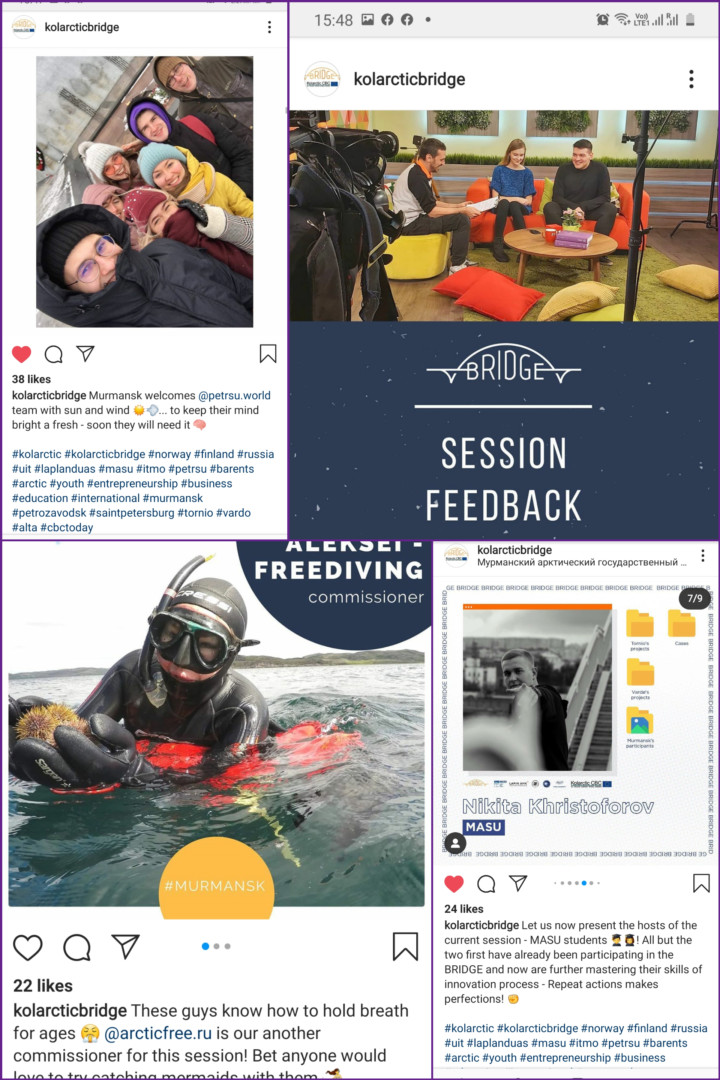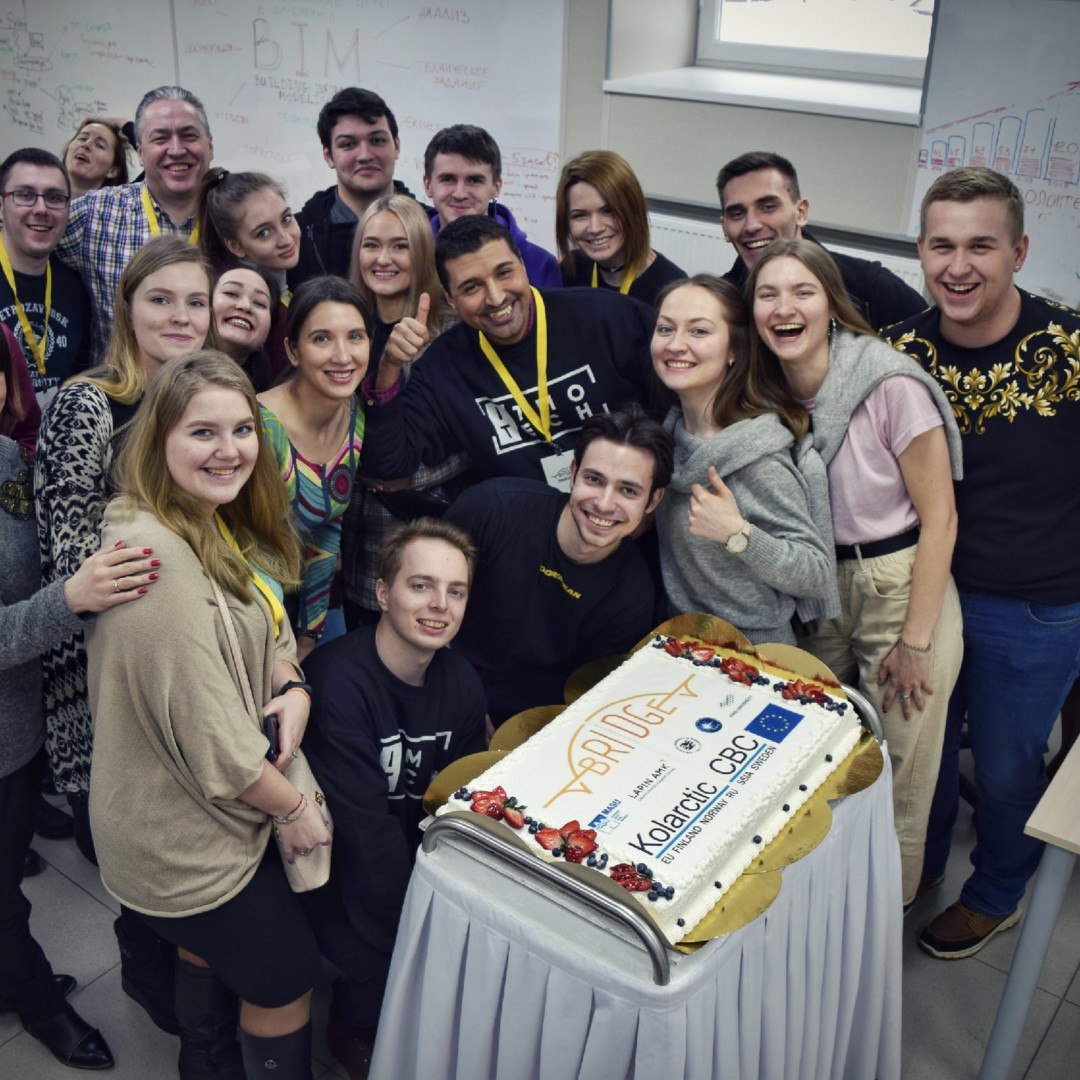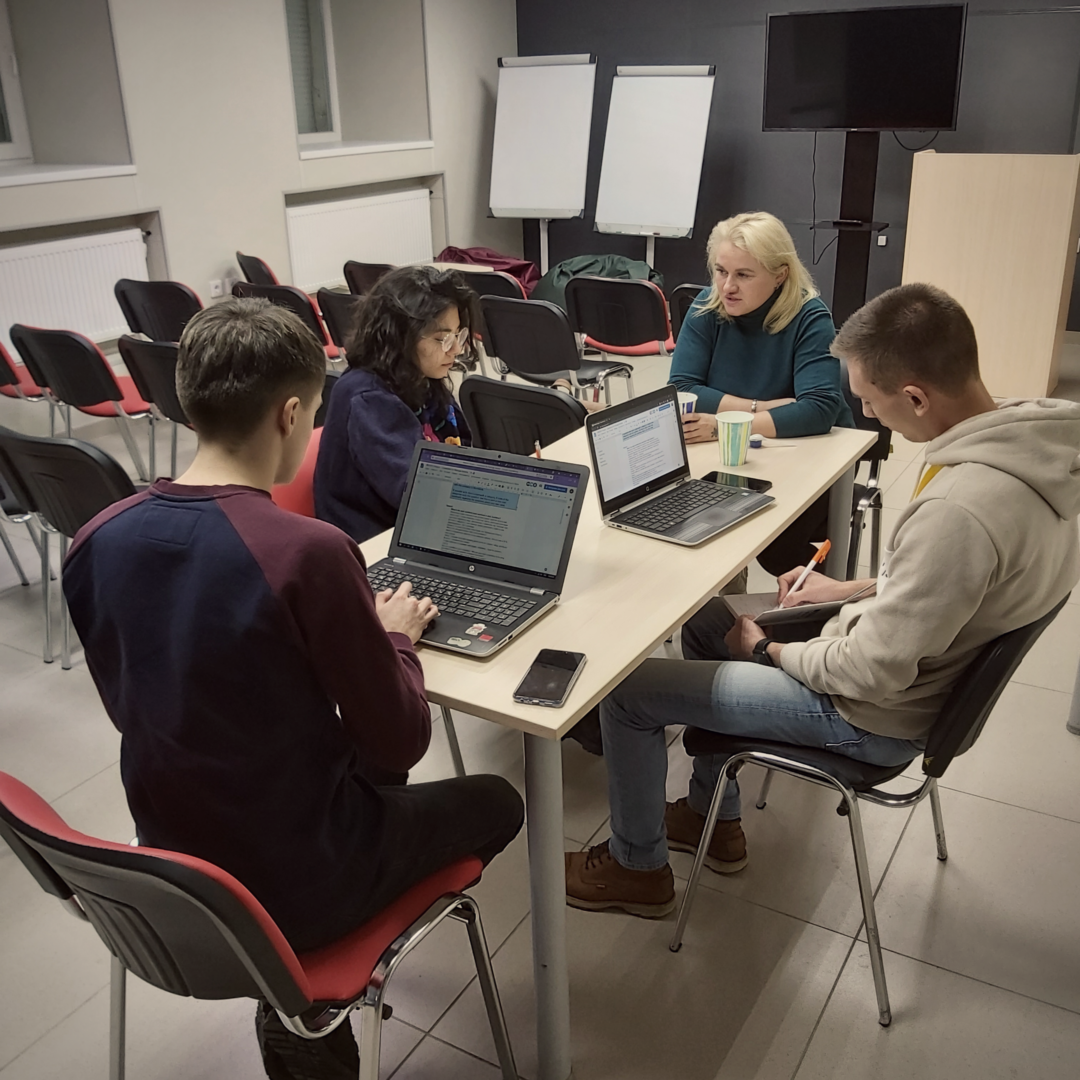
Kolarctic BRIDGE is using Instagram to actively engage the students, commissioners and coaches, also between online and face-to-face meetings. Mikhail Uksusov, who works as a visibility manager in the project, keeps people within the project in touch, and ensures that also others hear about the activities and results. Without communication, there is no cooperation.
In early March, Murmansk staff of a Kolarctic project BRIDGE was busy preparing the kick-off of the project’s third international session. Students and their coaches from Alta, Petrozavodsk, Rovaniemi, Tornio and St. Petersburg were packing their suitcases, and Murmansk Arctic State University hurried up to prepare assignments with local entrepreneurs participating in the project as commissioners, and drew final schedules for the arrival of international teams.
Then international travel went out of the window, just a couple of days before the start of the event. Who could have known?
Kolarctic BRIDGE is a project that brings together students and small businesses from the participating regions. Teachers in universities and universities of applied sciences present a list of SMEs with different business development cases to the students. The students make their choice, and cases attracting interest of from different countries get to stay. International teams are formed, teachers turn to coaches, and participating businesses into commissioners. Everything is set for the students and commissioners to meet and get to work.
The closure of borders put an end to the packing, but not much more. When the goal is set but borders close, you have to find another way. Web cameras were placed, computers set, digital connections established and online working spaces created. This was not entirely new, as enabling cooperation over long distances by employing digital platforms is part of the project idea. International cooperation does not always require mobility of people. Instead, ideas and knowledge must move.
Teambuilding, getting to know the commissioners, setting up communication platforms and then go! Having introduced the participants and cases already on Instagram, the communication between the students did not have to start from zero. The international teams representing multiple faculties had one week to analyse the case at hand, and come up with a concrete plan to help the commissioner to enhance their business. The coaches and organizers worked with the commissioners to define tasks that would benefit both the students and the businesses. As one of the coaches, associate professor of the Murmansk Arctic State University Alla Raspopova pointed out, it is not easy for the businesses to define and communicate their needs, let alone to come up with a clear task the students could take on immediately. This process takes time and expertise. Moreover, as it happens in real life, sometimes things changed on the go. That is business as usual, and even more so, when the development coincides with a global pandemic.
At the end of the week of hard work and collaboration on WhatsApp, Teams, Google Docs, Instagram and many more (only the students know), the teams gathered online and in Murmansk to present their plans to the commissioners. The ideas were fresh and forward-looking, and included action plans for realising positive change the teams were after. After feedback and reflection from the commissioners, coaches and other teams, it was time for a mid-term cake and coffee. The students are still to walk the talk, but well done so far!
 ADRIANA SANCHEZ, UiT The Arctic University of Norway – summary from her personal case work diary
ADRIANA SANCHEZ, UiT The Arctic University of Norway – summary from her personal case work diary
“Before starting this course and this project, I didn’t think it would be so enriching. I only thought about a free trip to Russia and some basic business knowledge, a field that I don’t know much about it due to my studies. Now, I think that signing up for this course was the best decision of the semester. When I started these classes, I felt very lost in the explanations […] . However, now I think I have learned a lot, and it will help me in the future for sure. I have realized that business is not just a theory, but a lot of work and imagination. This experience has allowed me to experience what fieldwork is. […] I have also left my comfort zone, and it has been very important to me. I do not know if I have made everything perfect, but I know that I have worked to achieve that perfection. I have had great colleagues and teachers and learned from another culture along the way, which is priceless. Kolarctic Bridge also offers an incredible opportunity to develop businesses with the help of students, who are sorely lacking in practical experience. Thank you.”
Simultaneously, the project team of the BRIDGE is working on a change of its own. The institutions of higher education are looking for ways to connect students with the world of work and its players in the arctic regions. While young people are heading to bigger national centres for employment opportunities, development-oriented companies in the north face shortage of dynamic, internationally skilled and educated workforce fit to work with real life challenges. The project aims at connecting the two. Besides offering international and hands-on business development opportunities for individual students and businesses, the project is coming up with a new way of organising the connections between educational institutions and the world of work. By providing a platform for students and businesses to meet, the project enables new connections and mobility of ideas. By offering the expertise and time of coaches, commissioners and coordinators, the focus of tasks stays clear and mutually beneficial for both academic and business aspirations. Could this be one of the futures of internships in the arctic?

Photo: Mikhail Uksusov
After the weeklong event hosted from Murmansk, the teams continued to work on their assignments and business development. The know-how of multidisciplinary teams was put into work, and during the eight-week implementation time websites, apps, marketing strategies, designs of new services and many other started to take shape. Each team took responsibility for organizing their own work and regular interaction with the coaches and commissioners.
In mid-May, it was time to deliver the final presentations, see the results and nominate the top team among the great ones. The commissioners thanked the teams for their hard work, holistic approach and commitment to results. A thing that gained extra significance during the spring was the teams’ capability s to adapt amidst the changing conditions and tasks.
Peter Fischer, the project manager of Kolarctic BRIDGE and university lecturer of UiT the Arctic University of Norway, tells that some cooperation activities carried out during the previous sessions in Vardø and Tornio have already resulted in tangible business development and job offers. However, he highlights that the real value of participation is about opening eyes. The academic and business benefits are building a base on which future cooperation and development can be build. Seeing opportunities, having the courage to try something new, learning the value of various approaches, and establishing contacts are prerequisite for that.
 LISA KAMPMANN, UiT The Arctic University of Norway – from a summary of her personal case work diary
LISA KAMPMANN, UiT The Arctic University of Norway – from a summary of her personal case work diary
“…the major learning I got from this course is not about business development or innovations but about intercultural communication. I learned, that working with students from different countries might also mean different ways of working and different approaches to tasks that have to be done… I would recommend every student to partake in a project that connects students from different countries, because it helps to educate oneself on different cultures and ways of working.”

Photo: Mikhail Uksusov
The project isn’t ending here. The project is now recruiting and preparing its next participants for the autumn session, where the students work on the business tasks given by commissioners in Petrozavodsk. In addition to having new cases and commissioners, the project is also a learning process. Each session brings new ideas. While Murmansk session introduced an educational approach by providing expert lectures for the students, in Petrozavodsk we will see a series of training for both students and coaches. After all, the coaches need coaching, too.
As one of the future challenges, Peter Fischer mentions a development of common digital platform that would fit the needs of cooperation. Online cooperation over long distances does not necessarily require coming up with a single solution, but establishing grounds for common meetings, dealing with confidential information from businesses, and coordinating the work is important. Various tools have been tried and tested, and the students are very resourceful in online communication. It might well be that effective online interaction is something where the students teams in Kolarctic BRIDGE hold expertise that would be valuable for all of us. The future of international Arctic cooperation needs communication tools, but most importantly, dedicated and motivated people, working to reach their common goals.
 MAIJU PUISEVA, Master’s student, Lapland University of Applied Sciences
MAIJU PUISEVA, Master’s student, Lapland University of Applied Sciences
“During the project while I was doing a research for the commissioner I gained in-depth knowledge of the commissioner’s field of business which otherwise would not have had.”
Oh yes, and which team was awarded as a winner of the Murmansk session? To find out, check out the #KolarcticBRIDGE on Instagram. Once there, take also a moment to meet the participants of the project. For the team’s presentations, stay tuned at the project’s website at https://kolarcticbridge.com/


